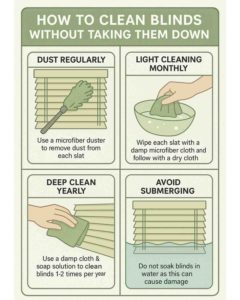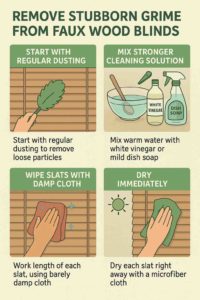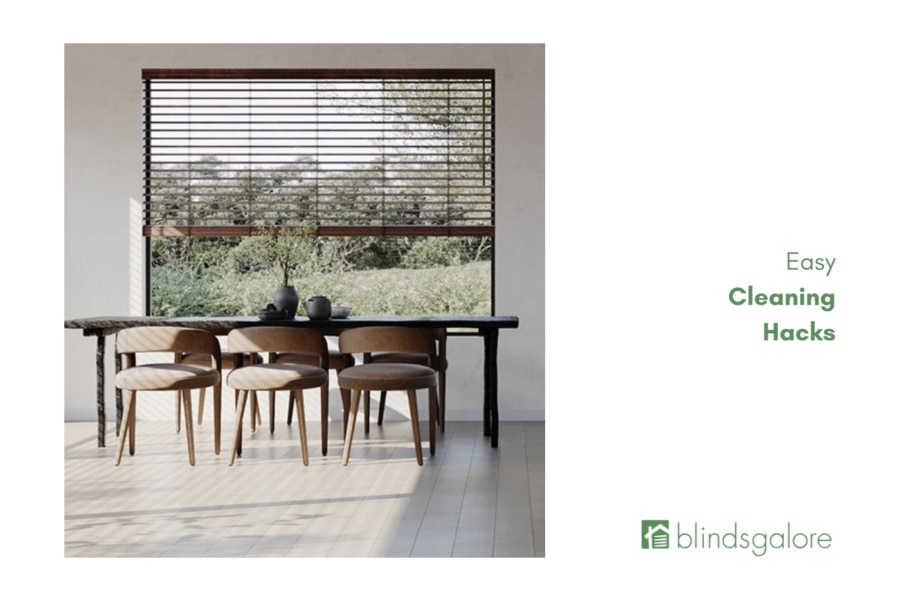What’s the Best Way to Clean Blinds Without Taking Them Down?

The best way to clean blinds starts with knowing what NOT to do. Never submerge blinds in water, not wood, faux wood, fabric, mini blinds, or any other type. Water submersion damages internal mechanisms, causes warping, and voids your warranty. No exceptions, whether motorized, blackout, or light filtering blinds.
Regular dusting prevents buildup that makes deep cleaning necessary. Using a microfiber duster vs. cloth comparison shows microfiber grabs dust better. Work from top to bottom, cleaning each slat individually. For horizontal Venetian blind cleaning tricks, close completely, dust one side, then reverse slats to clean the other side.
Monthly light cleaning keeps blinds fresh between deep cleanings. Mix a few drops of dish soap in warm water, your basic DIY blind cleaning solution. Dip a microfiber cloth in the solution, wring until barely damp, then wipe each slat. Follow immediately with a dry cloth to prevent water spots or damage. Like Mr. Miyagi taught in The Karate Kid, “wipe on, wipe off” for streak-free results.
Deep cleaning happens once or twice yearly, depending on the environment. Dusty areas, homes with pets, or rooms with heavy use need more frequent deep cleaning stained blinds. The process varies by material, which we’ll cover for each blind type.
How Often Should You Clean Window Blinds for Best Results?
How often to clean window blinds depends on several factors. High-traffic areas need attention every two weeks. Bedrooms and formal living spaces can go monthly. Seasonal cleaning tips suggest deep cleaning in spring and fall, with regular dusting in between.
Creating a blind maintenance schedule keeps cleaning manageable. Monday might be bedroom dusting day. Friday tackles kitchen blinds before weekend cooking. Breaking tasks into small chunks feels less overwhelming than marathon cleaning sessions. As Marie Kondo might ask, “Do your dust-covered blinds spark joy?” If not, let’s tackle the problem systematically.
Allergy-proofing home strategies require more frequent blind cleaning. Dust mites and pollen accumulate on horizontal surfaces, triggering symptoms. Weekly vacuuming with a vacuum brush attachment reduces allergens significantly. HEPA filters capture particles rather than redistributing them.
Preventing dust accumulation saves cleaning time long-term. Keep windows closed on windy days. Change HVAC filters monthly. Position furniture to minimize dust-carrying air currents across blinds. Small environmental changes make big differences in cleaning frequency.
The “Adhesive Brush” Cleaning Blinds Hack (Lint Rollers)
If you are dealing with pet hair or stubborn dust that just floats into the air when you dust, you need the adhesive brush cleaning blinds method.
- The Tool: A standard sticky lint roller.
- The Hack: Swipe the lint roller across the slats. The adhesive grabs the dust instantly without spreading it to the furniture below. This is arguably the fastest way to clean fabric shades or textured faux wood slats.
The Paintbrush Method
If you are searching for a brush clean blind cleaning blinds tool, look in your garage. A clean, dry 2-inch paintbrush is the perfect size for dusting window blinds. The soft bristles get into the tiny crevices where the string ladder meets the slat—a spot that clothes often miss.
What’s the Fastest Method for Dusting Blinds?
How to dust blinds efficiently saves time and prevents reducing airborne dust throughout your room. Start by closing windows and turning off ceiling fans. Gather supplies: microfiber cloths, vacuum with brush attachment, and possibly an extendable duster for high windows.
The vacuum method works fastest for regular maintenance. Use the brush attachment on low suction to prevent damaging slats. For horizontal blinds, close flat and vacuum across. Tilt slats the opposite direction and repeats. Vertical blind dust removal needs individual attention to hold each vane steady while vacuuming top to bottom.
Microfiber cloths outperform traditional dusters significantly. Wrap cloth around tongs or a ruler for easier reach between slats. Some prefer microfiber gloves for gripping each slat while dusting. Work systematically left to right, top to bottom, avoiding missed spots.
The two-handed technique speeds up the process. Hold microfiber cloth in both hands, placing on opposite sides of slats. Slide both hands along simultaneously, cleaning both sides at once. Half the time to get twice as clean!
How Do You Remove Stubborn Grime from Faux Wood Blinds?
 How to clean faux wood blinds takes advantage of moisture-resistant properties. Our Blindsgalore Faux Wood Blinds handle more aggressive cleaning than real wood, perfect for kitchens and bathrooms where removing stubborn grime becomes necessary.
How to clean faux wood blinds takes advantage of moisture-resistant properties. Our Blindsgalore Faux Wood Blinds handle more aggressive cleaning than real wood, perfect for kitchens and bathrooms where removing stubborn grime becomes necessary.
Start with regular dusting to remove loose particles. For grease and kitchen blinds situations, create a stronger cleaning solution. Mix warm water with tablespoon of white vinegar or mild dish soap. Vinegar cuts through cooking residue while soap lifts general dirt.
Apply a cleaning solution with barely damp cloth. Work one slat at a time, wiping along length rather than across. Prevents bending or warping slats. Pay attention to edges where dust accumulates. Sticky residue on blinds might need a slightly stronger solution or longer dwell time.
Dry each slat immediately after cleaning. Faux wood resists moisture damage, but standing water still causes problems with lifting mechanisms. Creates unsightly spots too. A dry microfiber cloth works best for final wipe-down, leaving blinds spotless.
What Special Care Do Real Wood Blinds Need?
How to clean wood blinds requires gentler methods than composite care approaches. Real wood can warp, crack, or develop water stains if cleaned improperly. Natural material needs respect and proper technique to maintain beauty.
Dusting remains the primary cleaning method for cleaning painted wood blinds or stained finishes. Use soft microfiber cloth or lamb’s wool duster weekly. Avoid static-producing materials attracting more dust. For thorough dusting, close blinds completely, dust one side, flip and dust the other.
When deeper cleaning becomes necessary, use minimal moisture. Slightly dampen microfiber cloth with water, barely moist, not wet. Add a drop of wood-safe cleaner if needed. Wipe each slat individually, following wood grain. Never spray cleaners directly on real wood vs. composite care situations.
Polish wood blinds occasionally for luster maintenance. Use furniture polish sparingly too much creates buildup attracting dust. Apply polish to cloth first, then wipe blinds. Once or twice yearly polishing suffices. Skip entirely in humid environments where polish might trap moisture.
What’s the Best Approach for Cleaning Mini Blinds?
How to clean mini blinds challenges homeowners because narrow slats bend easily. Affordable blinds need careful handling but clean nicely with the right approach. The key lies in gentle work avoiding permanent creases or damage.
Remove loose dust using vacuum’s brush attachment on low suction. Support the bottom of blinds with one hand while vacuuming. Prevents excessive movement causing damage. Work across slats systematically. Don’t rushbent mini blinds look terrible and won’t straighten completely.
For yellowing plastic blinds, the bathtub method works with modifications. Instead of submerging, lay blinds flat in an empty tub. Spray with a mixture of warm water and gentle cleaner. Let sit for 5 minutes, rinse with a handheld shower head. Hang immediately for complete drying before reinstalling.
Kitchen mini blinds accumulate grease regular cleaning won’t remove. Mix equal parts white vinegar and warm water in a spray bottle. Spray lightly on closed blinds, wait 2-3 minutes, then wipe with microfiber cloth. Natural cleaning hacks like vinegar cut through grease without harsh chemicals.
How Should You Clean Fabric Window Treatments?
Fabric blind maintenance differs from hard-surface blinds. Cellular shade cleaning, Roman shade care instructions, and roller shades like our Blindsgalore Envision Light Filtering Roller Shades require gentle cleaning maintaining appearance and function.
Regular vacuuming prevents deep dirt penetration into fabric fibers. Use upholstery attachment on low suction, working top to bottom. For cellular shades, vacuum along pleats carefully avoiding crushing cells. Hold the bottom rail steady preventing excess movement during cleaning.
Spot cleaning handles most stains on fabric shades. Blot spills immediately don’t rub, which spreads stains. Use white cloth dampened with a mild soap solution. Test cleaners in inconspicuous areas first. Work from stains outside inward preventing spreading.
Professional cleaning might be necessary for heavily soiled fabric shades. Some materials accept gentle machine washing, but check manufacturer guidelines first. Most cellular and pleated shades need professional ultrasonic cleaning maintaining shape and function.
Which Cleaning Products Work Best for Different Blind Materials?
Choosing right cleaning products prevents damage while ensuring effective results. Most blinds need only simple, gentle cleaners already at home. Harsh chemicals often cause more harm than good, especially on specialized coatings or materials.
For general cleaning, warm water with dish soap handles most situations. As Nancy Birtwhistle outlines in Clean & Green, natural cleaning hacks work wonderfully. White vinegar mixed with water (1:1 ratio) tackles tougher grime naturally. Always test cleaners in hidden areas first.
Avoid certain products on any blinds: bleach, ammonia-based cleaners, abrasive scrubbers, and oil-based products. Can discolor materials, break down protective coatings, or leave residues attracting more dirt. Even “gentle” all-purpose cleaners might be too harsh for certain materials.
Best blind cleaning tools make jobs easier but aren’t necessary. Microfiber blind cleaners with multiple fingers clean several slats simultaneously. Blind cleaning brushes reach tight spaces. However, simple microfiber cloths and gentle solutions work equally well with more time invested.
What’s the Key to Extending the Life of Your Blinds?
- Extending the life of your blinds requires consistent care and prevention strategies. Simple habits reduce cleaning frequency and preserve mechanisms. Open windows on opposite home sides reducing dust-carrying drafts across blinds. Use exhaust fans while cooking minimizing grease distribution.
Regular operation prevents mechanism problems. Raise and lower blinds weekly, even in rarely-used rooms. Keeps cords, springs, and gears functioning smoothly. Listening for unusual sounds during operation squeaking or grinding indicates attention needed.
- Protecting blinds from sun damage matters in bright rooms. UV rays fade colors and weaken materials over time. Consider UV-protective window films or alternate blind positions throughout the day. Distribute wear evenly rather than concentrating damage in one spot.
Address problems immediately before worsening. Tighten loose brackets noticing wobbling. Replace worn cord loops before complete breakage. Clean sticky residue from slats before attracting more dirt. Small fixes prevent expensive replacements later.
When Should You Consider Professional Blind Cleaning?
Most blind cleaning succeeds with DIY methods. Save money and clean on your schedule. Techniques shared handle 95% of cleaning situations effectively. With proper tools and patience, results match professional cleaning for regular maintenance.
Professional cleaning makes sense for certain situations. Antique or delicate blinds need expert handling. Severely neglected blinds might require ultrasonic cleaning equipment. Multiple stories of blinds could justify professional service for time savings. Like the janitor in Good Will Hunting, sometimes simple tasks done right make all the difference.
Our warranty doesn’t require professional cleaning. Free 3-year warranty (5-year upgrade available) covers manufacturing defects regardless of cleaning source. However, the warranty doesn’t cover damage from improper cleaning or sun fading. Follow guidelines maintaining coverage.
Consider professional cleaning after home renovations. Construction dust penetrates mechanisms in ways regular cleaning can’t address. Professionals have tools for deep-cleaning internal components without disassembly. One-time service after major dust exposure extends blind life significantly.
The Ultimate Cleaning Venetian Blinds Hack (Kitchen Tongs)
Cleaning individual slats takes forever. Speed it up with this viral cleaning venetian blinds hack:
- Grab Tongs: Take a pair of metal kitchen tongs.
- Wrap Them: Secure a microfiber cloth (or an old sock) around each side of the tongs using rubber bands.
- Clamp and Slide: Clamp the tongs onto a slat (one arm above, one arm below) and slide across.
- Why it works: You clean both sides of the slat simultaneously, cutting your cleaning time in half.
What Common Mistakes Ruin Blinds During Cleaning?
The biggest cleaning mistake remains submerging blinds in water. No matter how dirty blinds appear, water submersion destroys internal mechanisms, warps materials, voids warranties. Applies to every blind type no exceptions exist.
Wrong cleaning products cause permanent damage. Furniture polish on faux wood creates sticky buildup. Glass cleaner on fabric shades leaves spots. All-purpose cleaners might strip protective coatings. Stick to recommended products for each material type.
Aggressive cleaning bends or breaks components. Pressing hard while wiping creases slats permanently. Pulling cords at angles stresses mechanisms. Forcing stuck blinds causes more damage than patient troubleshooting. Gentle handling preserves appearance and function.
Ignoring manufacturer guidelines voids warranties and shortens blind life. Each blind type has specific care requirements. What works for faux wood might destroy real wood. Martha Stewart’s Homekeeping Handbook emphasizes following proper procedures ensures decades of use from quality items.
The Best Way to Clean Wooden Blinds
Real wood requires special care because water can cause warping or discoloration. The best way to clean wooden blinds is the “Low-Moisture” method:
- Never Soak: Avoid water buckets or bathtubs.
- Wood Polish: Use high-quality furniture polish on a soft cloth. This not only cleans the dust but conditions the wood and creates an anti-static barrier that repels future dust.
- The Glove Trick: Put on a white cotton glove, spray the glove lightly with polish, and run your fingers along the slats.
How to Clean Roller Blinds
Roller shades are essentially fabric, so you can’t scrub them like hard slats. Here is how to clean roller blinds safely:
- Vacuum First: Use the upholstery attachment on your vacuum to remove surface dust.
- Spot Clean Only: If there is a stain, use a sponge dampened with warm soapy water (mild dish soap). Dab—do not rub—the stain.
- Dry Completely: Leave the blind fully unrolled until it is 100% dry. Rolling it up while damp can cause mold or mildew growth inside the headrail.
Frequently Asked Questions
Avoid steam cleaners on most blinds. High heat and moisture warp slats, damage lift mechanisms, cause delamination in composite materials. Stick to damp cloth cleaning for safer results.
Mix equal parts white vinegar and warm water. Spray lightly on grease, let sit for 5 minutes, wipe with microfiber cloth. Repeat if necessary. For stubborn grease, add a drop of dish soap to the mixture.
Use vacuum with brush attachment first removing loose dust. Follow with microfiber cloths or cleaning gloves, working both hands simultaneously. The two-step process handles heavy dust efficiently.
Generally no. Cleaning blinds without taking them down prevents damage from removal and reinstallation. Only remove for severe situations requiring professional cleaning or when replacing entirely.
Use fabric softener sheets wiping blinds after cleaning. Anti-static properties repel dust longer. Alternatively, add a tiny amount of fabric softener to cleaning water for similar effects. Mary Poppins might say you don’t need a spoonful of sugar, just the right anti-static technique!

